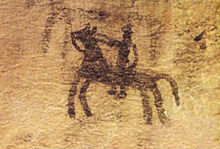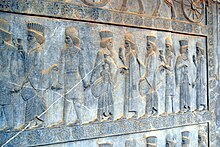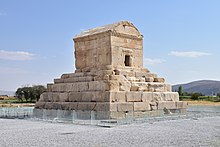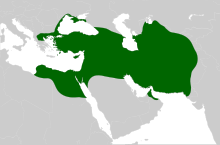Iran (Persian: ایران Irān [ʔiːˈɾɒːn] (About this sound listen)), also known as Persia (/ˈpɜːrʒə/), officially the Islamic Republic of Iran (Persian: جمهوری اسلامی ایران Jomhuri-ye Eslāmi-ye Irān (About this sound listen)), is a sovereign state in Western Asia.With over 81 million inhabitants, Iran is the world's 18th-most-populous country. Comprising a land area of 1,648,195 km2 (636,372 sq mi), it is the second-largest country in the Middle East and the 17th-largest in the world. Iran is bordered to the northwest by Armenia and the Republic of Azerbaijan,[a] to the north by the Caspian Sea, to the northeast by Turkmenistan, to the east by Afghanistan and Pakistan, to the south by the Persian Gulf and the Gulf of Oman, and to the west by Turkey and Iraq. The country's central location in Eurasia and Western Asia, and its proximity to the Strait of Hormuz, give it geostrategic importance. Tehran is the country's capital and largest city, as well as its leading economic and cultural center.
Iran is home to one of the world's oldest civilizations,beginning with the formation of the Elamite kingdoms in the fourth millennium BCE. It was first unified by the Iranian Medes in the seventh century BCE, reaching its greatest territorial size in the sixth century BCE, when Cyrus the Great founded the Achaemenid Empire, which stretched from Eastern Europe to the Indus Valley, becoming one of the largest empires in history. The Iranian realm fell to Alexander the Great in the fourth century BCE and was divided into several Hellenistic states. An Iranian rebellion culminated in the establishment of the Parthian Empire, which was succeeded in the third century CE by the Sasanian Empire, a leading world power for the next four centuries.
Arab Muslims conquered the empire in the seventh century CE, displacing the indigenous faiths of Zoroastrianism and Manichaeism with Islam. Iran made major contributions to the Islamic Golden Age that followed, producing many influential figures in art and science. After two centuries, a period of various native Muslim dynasties began, which were later conquered by the Turks and the Mongols. The rise of the Safavids in the 15th century led to the reestablishment of a unified Iranian state and national identity, with the country's conversion to Shia Islam marking a turning point in Iranian and Muslim history. Under Nader Shah, Iran was one of the most powerful states in the 18th century, though by the 19th century, a series of conflicts with the Russian Empire led to significant territorial losses.Popular unrest led to the establishment of a constitutional monarchy and the country's first legislature. A 1953 coup instigated by the United Kingdom and the United States resulted in greater autocracy and growing anti-Western resentment.Subsequent unrest against foreign influence and political repression led to the 1979 Revolution and the establishment of an Islamic republic, a political system that includes elements of a parliamentary democracy vetted and supervised by a theocracy governed by an autocratic "Supreme Leader". During the 1980s, the country was engaged in a war with Iraq, which lasted for almost nine years and resulted in a high number of casualties and economic losses for both sides.
According to international reports, Iran's human rights record is exceptionally poor. The regime in Iran is undemocratic, and has frequently persecuted and arrested critics of the government and its Supreme Leader. Women's rights in Iran are described as seriously inadequate, and children's rights have been severely violated, with more child offenders being executed in Iran than in any other country in the world. Since the 2000s, Iran's controversial nuclear program has raised concerns, which is part of the basis of the international sanctions against the country. The Joint Comprehensive Plan of Action, an agreement reached between Iran and the P5+1, was created on 14 July 2015, aimed to loosen the nuclear sanctions in exchange for Iran's restriction in producing enriched uranium.
Iran is a founding member of the UN, ECO, NAM, OIC, and OPEC. It is a major regional and middle power, and its large reserves of fossil fuels – which include the world's largest natural gas supply and the fourth-largest proven oil reserves – exert considerable influence in international energy security and the world economy.
The country's rich cultural legacy is reflected in part by its 22 UNESCO World Heritage Sites, the third-largest number in Asia and eleventh-largest in the world. Iran is a multicultural country comprising numerous ethnic and linguistic groups, the largest being Persians (61%), Azeris (16%), Kurds (10%), and Lurs (6%).
The term Iran derives directly from Middle Persian Ērān, first attested in a third-century inscription at Rustam Relief, with the accompanying Parthian inscription using the term Aryān, in reference to the Iranians. The Middle Iranian ērān and aryān are oblique plural forms of gentilic nouns ēr- (Middle Persian) and ary- (Parthian), both deriving from Proto-Iranian *arya- (meaning "Aryan", i.e. "of the Iranians"),recognized as a derivative of Proto-Indo-European *ar-yo-, meaning "one who assembles (skilfully)". In the Iranian languages, the gentilic is attested as a self-identifier, included in ancient inscriptions and the literature of the Avesta, and remains also in other Iranian ethnic names Alan (Ossetian: Ир Ir) and Iron (Ирон).
Historically, Iran has been referred to as Persia by the West, due mainly to the writings of Greek historians who referred to all of Iran as Persís (Ancient Greek: Περσίς; from Old Persian 𐎱𐎠𐎼𐎿 Pārsa),meaning "land of the Persians", while Persis itself was one of the provinces of ancient Iran that is today defined as Fars. As the most extensive interaction the Ancient Greeks had with any outsider was with the Persians, the term persisted, even long after the Persian rule in Greece.
In 1935, Reza Shah requested the international community to refer to the country by its native name, Iran. As The New York Times explained at the time, "At the suggestion of the Persian Legation in Berlin, the Tehran government, on the Persian New Year, Nowruz, March 21, 1935, substituted Iran for Persia as the official name of the country." Opposition to the name change led to the reversal of the decision, and Professor Ehsan Yarshater, editor of Encyclopædia Iranica, propagated a move to use Persia and Iran interchangeably. Today, both Iran and Persia are used in cultural contexts, while Iran remains irreplaceable in official state contexts.
Historical and cultural usage of the word Iran is not restricted to the modern state proper. "Greater Iran" (Irānzamīn or Irān e Bozorg) refers to territories of the Iranian cultural and linguistic zones. In addition to modern Iran, it includes portions of the Caucasus, Anatolia, Mesopotamia, Afghanistan, and Central Asia.
Pronunciation
The Persian pronunciation of Iran is [ʔiːˈɾɒːn]. Common English pronunciations of Iran are listed in the Oxford English Dictionary as /ɪˈrɑːn/ and /ɪˈræn/, in Merriam-Webster's online dictionary as /ɪˈrɑːn, -ˈræn, aɪˈræn/, and in Random House Webster's Unabridged Dictionary as /ɪˈræn, ɪˈrɑːn, aɪˈræn/. The Cambridge Dictionary lists /ɪˈrɑːn/ as the British pronunciation and /ɪˈræn/ as the American pronunciation. The Collins English Dictionary lists the pronunciation solely as /ɪˈrɑːn/. The pronunciation guide from Voice of America also provides /ɪˈrɑːn/.
The English pronunciation /aɪˈræn/ eye-RAN is sometimes heard in U.S. media. According to an article published by The Washington Post, the correct pronunciation of Iran is /iːˈrɑːn/, while /aɪˈræn/ is listed as the incorrect pronunciation. The American Heritage Dictionary of the English Language, in the dictionary's 2014 Usage Ballot, addressed the topic of the pronunciations of Iran and Iraq.According to this study, the pronunciations /ɪˈrɑːn/ and /ɪˈræn/ were almost equally acceptable, while /ɪˈrɑːn/ was preferred by most panelists participating in the ballot. With regard to the /aɪˈræn/ pronunciation, however, more than 70% of the panelists deemed it unacceptable. Among the reasons given by those panelists were that /aɪˈræn/ has "hawkish connotations" and sounds "angrier", "xenophobic", "ignorant", and "not...cosmopolitan".
Prehistory
Further information: Prehistory of Iran and Archaeological sites in Iran
A cave painting in Doushe cave, Lorestan, from the 8th millennium BC.
The earliest attested archaeological artifacts in Iran, like those excavated at Kashafrud and Ganj Par in northern Iran, confirm a human presence in Iran since the Lower Paleolithic. Iran's Neanderthal artifacts from the Middle Paleolithic have been found mainly in the Zagros region, at sites such as Warwasi and Yafteh. From the 10th to the seventh millennium BC, early agricultural communities began to flourish in and around the Zagros region in western Iran, including Chogha Golan,Chogha Bonut, and Chogha Mish.
The emergence of Susa as a city, as determined by radiocarbon dating, dates back to early 4,395 BC.There are dozens of prehistoric sites across the Iranian Plateau, pointing to the existence of ancient cultures and urban settlements in the fourth millennium BC.During the Bronze Age, the territory of present-day Iran was home to several civilizations, including Elam, Jiroft, and Zayanderud. Elam, the most prominent of these civilizations, developed in the southwest alongside those in Mesopotamia, and continued its existence until the emergence of the Iranian empires. The advent of writing in Elam was paralleled to Sumer, and the Elamite cuneiform was developed since the third millennium BC.
From the 34th to the 20th century BC, northwestern Iran was part of the Kura-Araxes culture, which stretched into the neighboring Caucasus and Anatolia. Since the earliest second millennium BC, Assyrians settled in swaths of western Iran, and incorporated the region into their territories.
Classical antiquity
Main articles: Median Empire, Achaemenid Empire, Seleucid Empire, Parthian Empire, and Sasanian Empire
See also: Indo-European migrations
A bas-relief at Persepolis, depicting the united Medes and Persians.
By the second millennium BC, the ancient Iranian peoples arrived in what is now Iran from the Eurasian Steppe, rivaling the native settlers of the region.As the Iranians dispersed into the wider area of Greater Iran and beyond, the boundaries of modern-day Iran were dominated by Median, Persian, and Parthian tribes.
From the late 10th to the late seventh century BC, the Iranian peoples, together with the "pre-Iranian" kingdoms, fell under the domination of the Assyrian Empire, based in northern Mesopotamia.Under king Cyaxares, the Medes and Persians entered into an alliance with Babylonian ruler Nabopolassar, as well as the fellow Iranian Scythians and Cimmerians, and together they attacked the Assyrian Empire. The civil war ravaged the Assyrian Empire between 616 and 605 BC, thus freeing their respective peoples from three centuries of Assyrian rule.The unification of the Median tribes under king Deioces in 728 BC led to the foundation of the Median Empire which, by 612 BC, controlled almost the entire territory of present-day Iran and eastern Anatolia. This marked the end of the Kingdom of Urartu as well, which was subsequently conquered and dissolved.
Tomb of Cyrus the Great, the founder of the Achaemenid Empire, in Pasargadae.
In 550 BC, Cyrus the Great, the son of Mandane and Cambyses I, took over the Median Empire, and founded the Achaemenid Empire by unifying other city states. The conquest of Media was a result of what is called the Persian Revolt. The brouhaha was initially triggered by the actions of Median ruler Astyages, and was quickly spread to other provinces, as they allied with the Persians. Later conquests under Cyrus and his successors expanded the empire to include Lydia, Babylon, Egypt, parts of the Balkans and Eastern Europe proper, as well as the lands to the west of the Indus and Oxus rivers.
539 BC was the year in which Persian forces defeated the Babylonian army at Opis, and marked the end of around four centuries of Mesopotamian domination of the region by conquering the Neo-Babylonian Empire. Cyrus entered Babylon and presented himself as a traditional Mesopotamian monarch. Subsequent Achaemenid art and iconography reflect the influence of the new political reality in Mesopotamia. Cyrus was notably mentioned in Hebrew Bible as the Persian king who released the exiled Jews from the Babylonian captivity and issued the decree for Jews to rebuild the Holy Temple in Jerusalem.
The Achaemenid Empire around the time of Darius I and Xerxes I.
At its greatest extent, the Achaemenid Empire included territories of modern-day Iran, Republic of Azerbaijan (Arran and Shirvan), Armenia, Georgia, Turkey (Anatolia), much of the Black Sea coastal regions, northeastern Greece and southern Bulgaria (Thrace), northern Greece and the Republic of Macedonia (Paeonia and Macedon), Iraq, Syria, Lebanon, Jordan, Israel and the Palestinian territories, all significant population centers of ancient Egypt as far west as Libya, Kuwait, northern Saudi Arabia, parts of the United Arab Emirates and Oman, Pakistan, Afghanistan, and much of Central Asia, making it the first world government and the largest empire the world had yet seen.
It is estimated that in 480 BC, 50 million people lived in the Achaemenid Empire.The empire at its peak ruled over 44% of the world's population, the highest such figure for any empire in history.
Ruins of the Gate of All Nations, Persepolis.
The Achaemenid Empire is noted for the release of the Jewish exiles in Babylon, building infrastructures such as the Royal Road and the Chapar (postal service), and the use of an official language, Imperial Aramaic, throughout its territories.The empire had a centralized, bureaucratic administration under the emperor, a large professional army, and civil services, inspiring similar developments in later empires.
Eventual conflict on the western borders began with the Ionian Revolt, which erupted into the Greco-Persian Wars and continued through the first half of the fifth century BC, and ended with the withdrawal of the Achaemenids from all of the territories in the Balkans and Eastern Europe proper.
In 334 BC, Alexander the Great invaded the Achaemenid Empire, defeating the last Achaemenid emperor, Darius III, at the Battle of Issus. Following the premature death of Alexander, Iran came under the control of the Hellenistic Seleucid Empire. In the middle of the second century BC, the Parthian Empire rose to become the main power in Iran, and the century-long geopolitical arch-rivalry between the Romans and the Parthians began, culminating in the Roman–Parthian Wars. The Parthian Empire continued as a feudal monarchy for nearly five centuries, until 224 CE, when it was succeeded by the Sasanian Empire. Together with their neighboring arch-rival, the Roman-Byzantines, they made up the world's two most dominant powers at the time, for over four centuries.
 Sasanian rock reliefs at Taq Bostan, in the heart of the Zagros Mountains.
Sasanian rock reliefs at Taq Bostan, in the heart of the Zagros Mountains.
The Sasanians established an empire within the frontiers achieved by the Achaemenids, with their capital at Ctesiphon. Late-antiquity Sasanian Empire is considered one of the most influential periods of Iran, as their influence reached the culture of ancient Rome (and through that as far as Western Europe), Africa, China, and India, and played a prominent role in the formation of the medieval art of both Europe and Asia.
 A bas-relief at Naqsh-e Rostam, depicting the victory of Sasanian ruler Shapur I over Roman ruler Valerian.
A bas-relief at Naqsh-e Rostam, depicting the victory of Sasanian ruler Shapur I over Roman ruler Valerian.
Most of the era of the Sasanian Empire was overshadowed by the Roman–Persian Wars, which raged on the western borders at Anatolia, the Western Caucasus, Mesopotamia, and the Levant, for over 700 years. These wars exhausted both the Romans and the Sasanians, and led to the defeat of both by the Muslim invasion.
Throughout the Achaemenid, Parthian, and Sasanian eras, several offshoots of the Iranian dynasties established eponymous branches in Anatolia and the Caucasus, including the Pontic Kingdom, the Mihranids, and the Arsacid dynasties of Armenia, Iberia (Georgia), and Caucasian Albania (present-day Republic of Azerbaijan and southern Dagestan).







